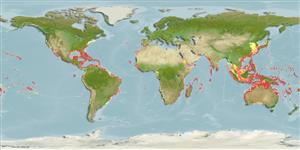Classification / Names
Common names from other countries
Main reference
Size / Weight / Age
Max length : 200 cm TL male/unsexed; (Ref. 7251); common length : 140 cm TL male/unsexed; (Ref. 3692); max. published weight: 50.0 kg (Ref. 6949)
Length at first maturity
Lm 66.0, range 58 - ? cm
Environment
Marine; brackish; reef-associated; depth range 1 - 100 m (Ref. 6949), usually 3 - 30 m (Ref. 40849)
Climate / Range
Subtropical, preferred 27°C (Ref. 107945); 42°N - 35°S, 180°W - 180°E (Ref. 55300)
Distribution
Indo-Pacific: Red Sea and east coast of Africa to Hawaii and the Marquesas and Tuamoto islands. Western Atlantic: Massachusetts (USA), Bermuda, and throughout the Caribbean Sea to Brazil (Ref. 9626). Eastern Atlantic: Sierra Leone, Côte d'Ivoire, Togo, Nigeria, Senegal (Ref. 6949), Mauritania (Ref. 5377), St. Paul's Rocks (Ref. 13121), and São Tomé Island (Ref. 34088).
Countries | FAO areas | Ecosystems | Occurrences | Introductions
Short description
Dorsal
spines
(total): 6;
Dorsal
soft rays
(total): 9;
Anal
spines: 1;
Anal
soft rays: 10. Distinguished by the double emarginate tail fin with pale tips on each lobe, and (usually) the presence of a few scattered black blotches on the lower sides (Ref. 1602). Top of head between eyes flat or concave; mouth large (Ref. 26938).
IUCN Red List Status (Ref. 115185)
Threat to humans
Traumatogenic (Ref. 4690)
Human uses
Fisheries: minor commercial; gamefish: yes; aquarium: public aquariums
Tools
Special reports
Download XML
Internet sources
Estimates of some properties based on models
Phylogenetic diversity index
PD50 = 0.5000 many relatives (e.g. carps) 0.5 - 2.0 few relatives (e.g. lungfishes)
Trophic Level
4.5 ±0.6 se; Based on diet studies.
Resilience
Low, minimum population doubling time 4.5 - 14 years (K=0.09-0.11; tm=2-4)
Vulnerability
Very high vulnerability (79 of 100)
Price category
